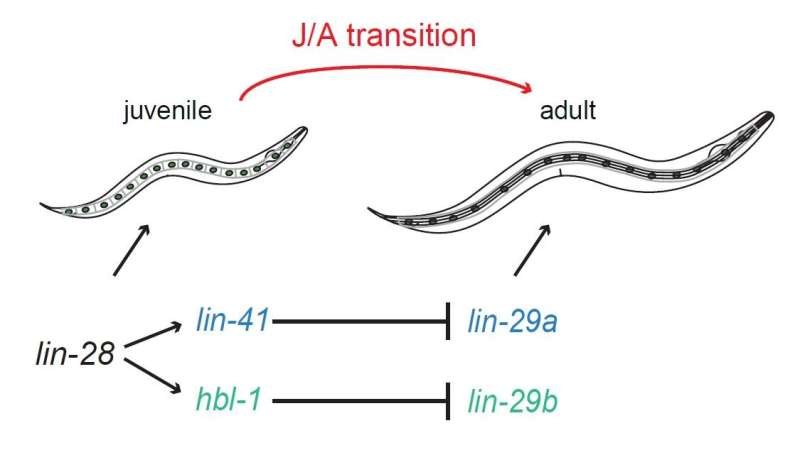Study: Genes that time juvenile-to-adult transition are triggered by a single protein

Genes that time the transition to adulthood are well-studied in the roundworm C. elegans, and at least partially conserved in mammals, where they regulate the onset of puberty. Juvenile worms turn into adults when a protein called LIN-29 accumulates in sufficient amounts. By studying two variants of LIN-29, the group of Helge Grosshans reveals that temporal coordination of events during the transition to adulthood involves a branched pathway rather than a linear chain of events.
Puberty—the period when sexual maturity is reached—constitutes a major transition in the lives of all animals. In mammals, it is not well understood how this juvenile-to-adult (J/A) transition is temporally coordinated and its onset timed. However, in C. elegans, a genetic pathway that times the J/A transition has been elucidated. The activity of this so-called heterochronic pathway is conveniently monitored by observing the worm skin and its outer shell, the cuticle, both of which mature in well-characterized, predictable ways during progression to adulthood. All changes that occur are triggered by the accumulation of a single protein, LIN-29. This ensures robust temporal coordination of the different events that make up the J/A transition.
Current models of the heterochromatic pathway depict a single linear chain of events that lead to the accumulation of LIN-29. However, multiple lines of evidence challenge the simple linear model. In particular, LIN-29 occurs in two variants, LIN-29a and LIN-29b, highly similar in their sequence and, supposedly, function, but only LIN-29a is regulated by LIN-41, the upstream gene in the heterochronic pathway.
Chiara Azzi and Florian Aeschimann from the Grosshans group set out to challenge the current models by studying the regulation of the two LIN-29 variants and their functions in the J/A transition. Their results have recently been published in eLife.
By introducing targeted changes in the C. elegans genome, they could individually inactivate the two LIN-29 variants and monitor their activity. They found that LIN-29a and LIN-29b have distinct functions—not because of differences in their sequences but because of distinct temporal patterns of accumulation. These result from their specific regulation by either LIN-41 or HBL-1, a heterochronic transcription factor. Accordingly, when either regulator is inactivated, temporal coordination of J/A transition events fails. Thus, co-regulation of LIN-41 and HBL-1 activity is the key to a temporally coordinated J/A transition. This is achieved by LIN-28, another heterochronic factor that controls both LIN-29 isoforms by regulating, likely indirectly, both LIN-41 and HBL-1.
Grosshans comments on the wider implications of the study: "The time of onset of puberty is genetically controlled—in part by human counterparts of C. elegans heterochronic genes. Hence, our work helps to understand the regulatory logic of a deeply conserved timing mechanism and could guide its experimental dissection in mammals. Given the transformative nature of puberty, a better understanding of the mechanisms that time it will be interesting for individuals and society, and may help to identify therapeutic opportunities for those that experience pathologically early or late onset of puberty."
More information: Chiara Azzi et al. A branched heterochronic pathway directs juvenile-to-adult transition through two LIN-29 isoforms, eLife (2020). DOI: 10.7554/eLife.53387
Journal information: eLife





















